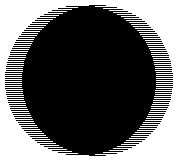
Video at 25 or 30fps is enough with human eye properties but on TV screen, image is perceived flickering. Engineers found that displaying the same frame in two parts (called fields), meaning one field is for the odd lines (1, 3, 5, 7...) and one field for the even lines (2, 4, 6, 8...) and doubling the rate (60 1/2 fps and 50 1/2 fps) avoid flicker thanks to screen remanence.
Therefore TV is interlaced video: 60 half-images per second for NTSC and 50 half-images per second for PAL.
More details provided by the ATSC (Advance Televison Systems Committee) at Basics of Video.
So if you capture AB frame, odd lines come from picture A and even lines from picture B, the two pictures have a time shift of 1/24 second. Therefore object moving have their odd lines and even lines shifted and it looks like:

And if scenes change on an AB or BC frame, see how it looks like with Example 1 :

I haven't found literature about PAL Telecine, it could result with AA AB BC CD DE.
Interlacing could come from CCD camcorder or PCTV frame grabber too, I haven't found any white paper from manufacturers but if you capture a progressive source and get interlaced video, your grabber is interlacing. A progressive scan (from brand new or professional camera) is a non-interlaced frame.
Actually, interlacing differs regarding video source : films, camcorder CCD or PCTV frame grabber.
| NTSC | PAL | SECAM | |
| images / second | 29.97 | 25 | 25 |
| ms / image | 33.37 | 40 | 40 |
| lines / image | 525 | 625 | 625 |
| aspect ratio | 4:3 | 4:3 | 4:3 |
| interlace | 2:1 | 2:1 | 2:1 |
| µs / line | 63.56 | 64.00 | 64.00 |
| digital resolution | 640x480 | 768x576 | 768x576 |
| more lines make video interlaced | 240 | 288 | 288 |
| CIF resolution | 320x240 | 352x288 | 352x288 |
| CCIR 601 luminance resolution | 720x485 | 720x576 | 720x576 |
| CCIR 601 chrominance resolution | 360x485 | 360x576 | 360x576 |
| Color subsampling | 4:2:2 | 4:2:2 | 4:2:2 |
Note: vertical resolution is less than 525 or 625 lines per image because some are used for blanking (synchronization). CIF is Common Intermediate Format, noninterlaced, every pixel carries Luma and Chroma, this format is less demanding because 1/4 of full size but it carries very accurate data. Yes, NTSC isn't 30fps but 29.97 !
So we have Luma coded with 720x576 pixels (NTSC 720x485) and Chroma with 360x576 (NTSC 360x485) therefore every line carries meaningful information and dealing with interlaced video makes sense (versus CIF).
Filters for VirtualDUB :
Blending fields is often highlighted as the best choice but I disagree because it blends time shifted information which can be totally inaccurate (with Telecine 3:2 when a scene change to another - like my Example 1 above with BC frame) and which results in blurring the picture. Interpolation is better to keep image sharpness. By the way, when interlacing is very dummy blending is the best solution (in the table of examples below, blend appears a lot).
I suggest to first take time to understand nature of interlaced video then to select the most appropriate filter, particularly with Telecine, and to do some testing.
I will try to fill this table from time to time (all captures are 768x576
uncompressed):
| Source | Standard | Program | Channel | Nature | Best Filter | Other Filters |
| Hi8 camcorder | 400x400 | PAL interlacing | smart (phase shift) + area based | |||
| Standalone DVD | 720x576 | US Movie | Telecine | telecide (field swap) | ||
| VCR (VHS) | 250x240 | |||||
| Terrestrial TV | 720x576 | News | France 2 | Progressive | field swap + area based | field swaps only |
| 720x576 | News | TF1 | Progressive | field swap + area based | ||
| 720x576 | US News | TF1 | Progressive | field swap + area based | ||
| Satellite TV | 720x576 | French News | Canal + | Unknown | field swap + smart (blend) | field swap + area based |
| 720x576 | French News | LCI | Unknown | field swap + area based (blend) | deinterlace (blend) | |
| 720x576 | French Sport | Canal + | Unknown | field swap + smart (blend) | field swap + area based (blend) | |
| 720x485 | US Sport | Canal + | Progressive | field swap + smart | field swap + area based | |
| 720x485 | US News | CNN | Telecine | telecide (field swap) | ||
| 720x485 | US sitcom | Comedie | Telecine | telecide (field swap) | field swap + area based | |
| 720x576 | French Cinema | Cinecinema | Telecine | telecide (field swap) |
I guess this table may help me and others to understand better how to deal with interlaced video.